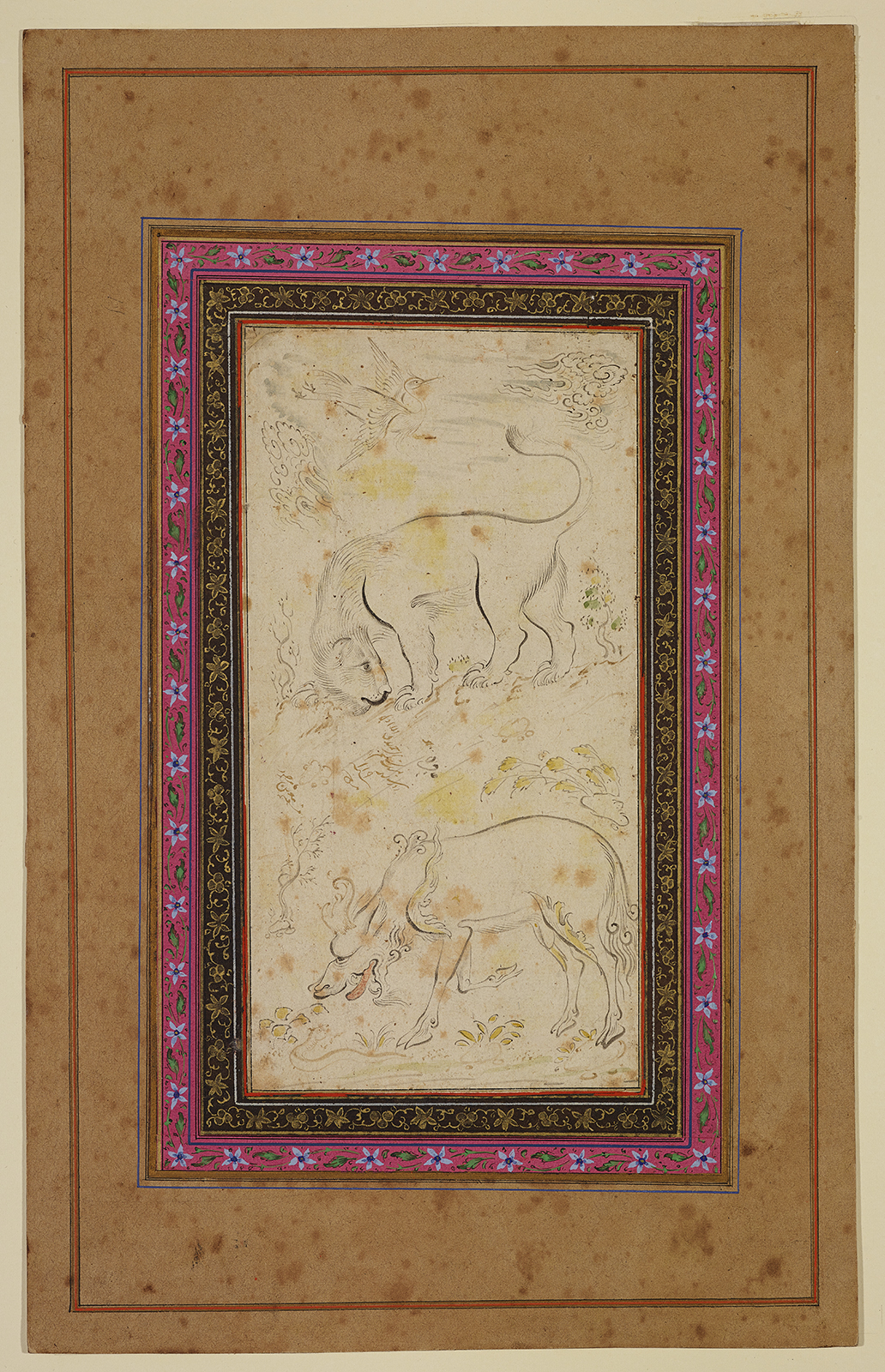Click on the image to zoom
A Lion and a Kylin
- Accession Number:AKM112
- Creator:signed by Mu’in Musavvir
- Place:Iran, Isfahan
- Dimensions:32.8 x 20.6 cm
- Date:26 Jamada al-Awwal 11[0]9 (December 10, 1697)
- Materials and Technique:ink, opaque watercolour, and gold on paper
This single-page slightly coloured drawing was mounted on a late 18th-century album page. It depicts four animals. A little snake and a horned kylin (a mythological creature with a horse-like body, dragon’s head, cloven hooves, paws, and flaming wings) occupy the foreground; a lion twists its head back toward the right, sniffing the air or considering an attack; and a crane flies from the left between Chinese clouds. The landscape has small, bare trees and leafy plants. The signature of the artist is written in gold in brush between the kylin and the lion, revealing the date as 26 Jamada al-Awwal 11[0]9 (December 10, 1697).
Further Reading
The prowling lion, executed with lucid and flowing lines, is similar to the lion by Mu’in Musavvir dated February 13, 1672. After 25 years, wealthy in experience, still spontaneous and unique in his draftsmanship, he again picks up this topic, which happens to be one of the animal topics mentioned by Sadeqi Beg in his treatise Qanun as-suwar (Canon of Painting, 1576–1602; see also AKM111). Sadeqi defined a genre of animal design, noting that artists needed to know principal animal types and their associated names. These included the simurgh (bird), azhdar (dragon), hejabr (winged lion), and gav-e ganj (winged bull).[2] Mu’in Musavvir follows Sadeqi’s advice by drawing two of the aforementioned creatures. The lion is the hejabr and the kylin is the deer-like gav-e ganj.[3] Sadeqi Beg recommended showing the animals fighting, the most dynamic position, but as rendered by Mu’in Musavvir, they could be drawn separately, too.
Mythical creatures, anchored in Chinese culture from ancient times, had since the 14th century been indispensable motifs in the repertoire of Iranian artists. They survived into the 17th century, along with the single-page drawings and paintings that had been in vogue since the late 16th century and were collected for assembly into an album.
Mu’in Musavvir, who was trained by Reza-e ‘Abbasi, had a long career and carried Reza-e ‘Abbasi’s artistic ideas and new styles into the 18th century. His dated works fall between 1635 and 1707.[4] Mu’in Musavvir was also one of the independent artists who worked at home or used their residences as studios. According to Massumeh Farhad, Mu’in Musavvir’s house also served as a place to exchange ideas, designs, and new compositions.[5] His animal studies, results of his fine draftsmanship, are a mixture of real observation and imaginative components.
— Filiz Çakır Phillip
Notes
[1] Martin Bernard Dickson and Stuart Cary Welch, eds., The Houghton Shahnameh, vol. 1 (Boston: Fogg Art Museum, Harvard University, 1981), 264.
[2] Dickson and Welch, 265.
[3] Joachim Gierlichs, Drache, Phönix, Doppeladler: Fabelwesen in der islamischen Kunst (Berlin: Gebr. Mann, 1993), 31; Karin Rührdanz, “Fabeltiere des Aleppo- Zimmers vor dem Hintergrund der Illustrationen naturhistorischer Kompendien.” In Angels, Peonies, and Fabulous Creatures: The Aleppo Room in Berlin, eds. Julia Gonnela and Jens Kröger (Münster: Rhema Verlag, 2008), 48.
[4] Massumeh Farhad, “The Art of Mu‘in Musavvir: A Mirror of His Times.” In Persian Masters: Five Centuries of Painting, ed. Sheila Canby (Mumbai: Marg Publications, 1990), 113–14.
[5] Massumeh Farhad, “An Artist’s Impression: Mu‘in Musavvir’s ‘Tiger Attacking a Youth,’” Muqarnas 9 (1992): 121.
References
Dickson, Martin Bernard, and Stuart Cary Welch, eds. The Houghton Shahnameh, vols. 1 and 2. Boston: Fogg Art Museum, Harvard University, 1981.
Farhad, Massumeh. “The Art of Mu‘in Musavvir: A Mirror of His Times.” In Persian Masters: Five Centuries of Painting, ed. Sheila Canby. Mumbai: Marg Publications, 1990, 113–28. ISBN: 9788185026107
---. “An Artist’s Impression: Mu‘in Musavvir’s ‘Tiger Attacking a Youth.’” Muqarnas 9 (1992): 116–23. ISBN: 978900409625
Gierlichs, Joachim. Drache, Phönix, Doppeladler: Fabelwesen in der islamischen Kunst. Berlin: Gebr. Mann, 1993. ISBN: 9783786117216
Phillip, Filiz Çakır. Enchanted lines: drawings from the Aga Khan Museum collection. 2014. ISBN: 9780991992874
Rührdanz, Karin. “Fabeltiere des Aleppo-Zimmers vor dem Hintergrund der Illustrationen naturhistorischer Kompendien.” In Angels, Peonies, and Fabulous Creatures: The Aleppo Room in Berlin, eds. Julia Gonnela and Jens Kröger. Münster: Rhema Verlag, 2008, 47–51. ISBN: 9783930454822
Soudavar, Abolala. “The Age of Muhammadi.” Muqarnas 17 (2000): 53–72. ISBN:9789004116696
Welch, Anthony. Collection of Islamic Art: Prince Sadruddin Aga Khan, vols. 1 and 3. Geneva: Château de Bellerive, 1972–78.
Note: This online resource is reviewed and updated on an ongoing basis. We are committed to improving this information and will revise and update knowledge about this object as it becomes available.


